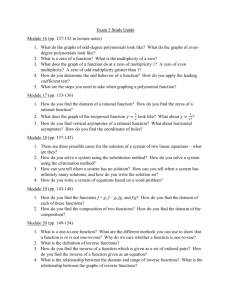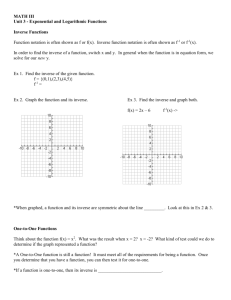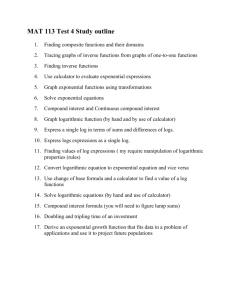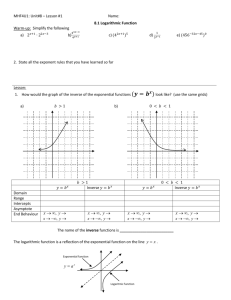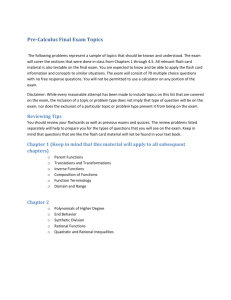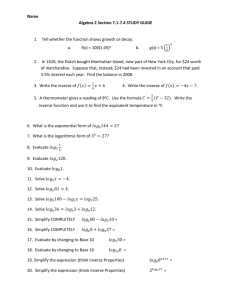Chapter 12, 13.1
advertisement
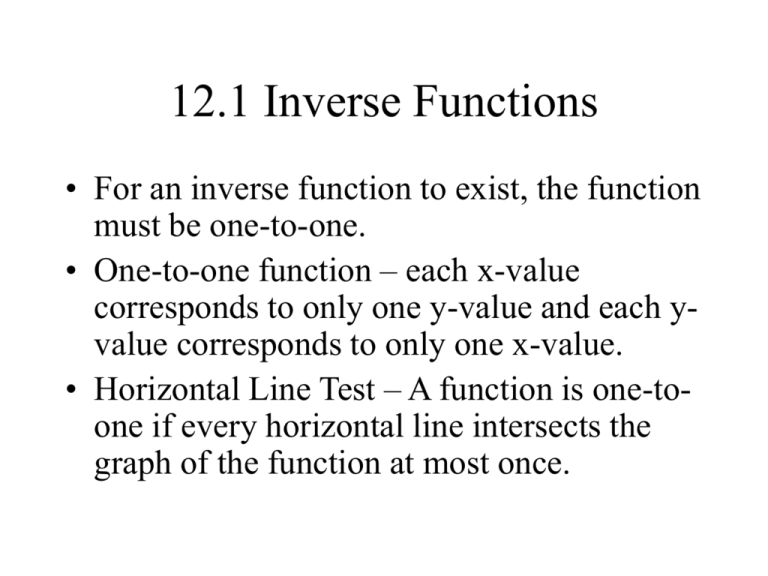
12.1 Inverse Functions • For an inverse function to exist, the function must be one-to-one. • One-to-one function – each x-value corresponds to only one y-value and each yvalue corresponds to only one x-value. • Horizontal Line Test – A function is one-toone if every horizontal line intersects the graph of the function at most once. 12.1 Inverse Functions • f-1(x) – the set of all ordered pairs of the form (y, x) where (x, y) belongs to the function f. Note: f -1(x) 1 f ( x) • Since x maps to y and then y maps back to x it follows that: f -1 ( f(x)) f 1 ( y) x 12.1 Inverse Functions • Method for finding the equation of the inverse of a one-to-one function: y f (x) 1. Interchange x and y. 2. Solve for y. 3. Replace y with f-1(x) 12.1 Inverse Functions • Example: y ( x 3)3 5 1. Interchange x and y. x ( y 3)3 5 2. Solve for y. x 5 ( y 3)3 3 x5 y3 3 x 5 3 y 3. Replace y with f-1(x) f 1 ( x) 3 x 5 3 12.1 Inverse Functions • Graphing inverse functions: The graph of an inverse function can be obtained by reflecting (getting the mirror image) of the original function’s graph over the line y = x 12.2 Exponential Functions • Exponential Function: For a > 0 and a not equal to 1, and all real numbers x, f ( x) a x • Graph of f(x) = ax: 1. Graph goes through (0, 1) 2. If a > 1, graph rises from left to right. If 0 < a < 1, graph falls from left to right. 3. Graph approaches the x-axis. 4. Domain is: (, ) Range is: (0, ) 12.2 Exponential Functions Graph of an Exponential Function f ( x) a (0, 1) x 12.2 Exponential Functions • Property for solving exponential equations: a a x y x • y Solving exponential equations: 1. Express each side of the equation as a power of the same base 2. Simplify the exponents 3. Set the exponents equal 4. Solve the resulting equation 12.2 Exponential Functions • Example: Solve: 9x = 27 (3 ) (3) 2 x 3 32 x 33 2x 3 x 3 2 12.3 Logarithmic Functions • Definition of logarithm: y y log a x x a • Note: logax and ax are inverse functions • Since b1 = b and b0 = 1, it follows that: logb(b) = 1 and logb(1) = 0 12.3 Logarithmic Functions • Logarithmic Function: For a > 0 and a not equal to 1, and all real numbers x, f ( x) log a x • Graph of f(x) = logax : 1. Graph goes through (0, 1) 2. If a > 1, graph rises from left to right. If 0 < a < 1, graph falls from left to right. 3. Graph approaches the y-axis. 4. Domain is: (0, ) Range is: (, ) 12.3 Logarithmic Functions Graph of an Exponential Function f ( x) a x Try to imagine the inverse function 12.3 Logarithmic Functions Inverse - Logarithmic Function f ( x) log a ( x) 12.3 Logarithmic Functions • Example: Solve x = log1255 In exponential form: 5 125 x In powers of 5: 5 (5 ) 5 5 1 3 x 1 3x Setting the powers equal: 1 3x x 13 12.4 Properties of Logarithms • If x, y, and b are positive real numbers where b 1 Product Rule: log b xy log b x log b y x Quotient Rule: log b log b x log b y y r log x r log b x Power Rule: b Special Properties: log b b x x and blogb x x 12.4 Properties of Logarithms • Examples: Product Rule: log 3 9 x log 3 9 log 3 x 2 log 3 x Quotient Rule: log 1000 log 1000 log y 3 log y 10 10 10 10 y Power Rule: log 34 4 log 3 5 5 Special Properties: log 12371 371 12 13.1 Additional Graphs of Functions Absolute Value Function • Graph of f ( x) x • What is the domain and the range? 13.1 Additional Graphs of Functions Graph of a Square Root Function • Graph of f ( x) x (0, 0) 13.1 Additional Graphs of Functions Graph of a Greatest Integer Function • Graph of f ( x) x Greatest integer that is less than or equal to x 13.1 Additional Graphs of Functions Shifting of Graphs • • Vertical Shifts: y f ( x) k The graph is shifted upward by k units Horizontal shifts: y f ( x h) The graph is shifted h units to the right y a f (x) • • If a < 0, the graph is inverted (flipped) If a > 1, the graph is stretched (narrower) If 0 < a < 1, the graph is flattened (wider) 13.1 Additional Graphs of Functions • Example: Graph f ( x) x 4 Greatest integer function shifted up by 4 13.1 Additional Graphs of Functions Composite Functions • Composite function: function of a function f(g(x)) = (f g)(x) Example: if f(x) = 2x – 1 and g(x) = x2 then f(g(x)) = f(x2) = 2x2 – 1 • What is g(f(2))? • Does f(g(x)) = g(f(x))?
